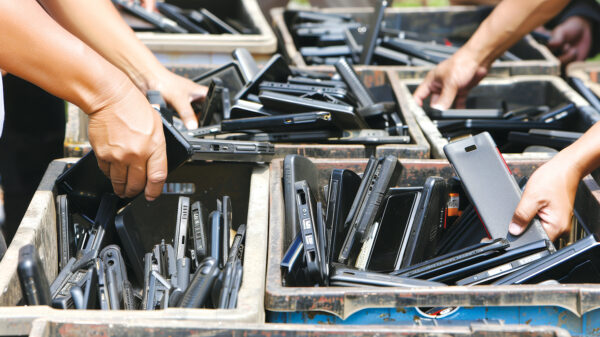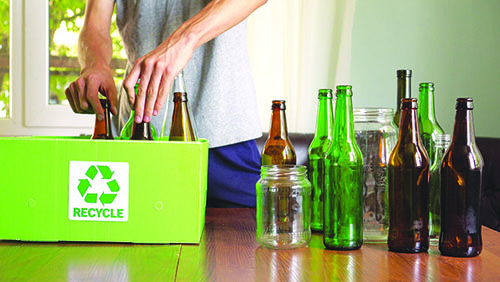The recent trend of converting old bike parts into chandeliers, wine corks into bathmats, or shipping containers into modern homes proves there are clever ways to use what might otherwise be useless junk.
The Defense Logistics Agency (DLA) doesn’t usually know what becomes of the military gear it reduces to scrap, but recycling unusable or excess items conserves natural resources, reduces waste sent to landfills and saves money so warfighters can buy better stuff.
The Department of Defense’s (DoD) authority on reutilization and disposal of everything from battle-damaged Humvees and worn-out flak vests to office furniture is DLA Disposition Services.
“When a unit is done with a piece of property or it doesn’t work anymore, they bring it to us and we get rid of it for them,” said Vickie Rodgers, deputy director for DLA Disposition Services’ central region. “That’s our specialty, and we do it in a compliant manner so it’s not released to the public until after it’s been properly processed.”
About 90 percent of the items DLA scraps are common things like fabric and textiles, lead, steel and wood.
“There’s a wide range of classifications for these materials,” said Tom Marcum, a lead sales contracting officer for DLA Disposition Services. “Steel, for example, comes in different grades. And then there are also different packages of steel, such as shavings, rods and bundles.”
Commodities like fired brass casings and aluminum make up the other 10 percent of items the agency scraps, and they typically have higher values, added Brienne Hallifax, a sales contracting officer in the Recycling Sales Branch.
Global Effort
Normal wear and tear of equipment, base closures and unit realignments make DLA’s scrap mission a steady and global endeavor. Property disposal specialists are co-located with units and deployed overseas to guide troops through the turn-in process and physically receive property.
“First, we do our best to reutilize excess property through our reutilization, transfer and donation program, which helps us keep as much of the good property as possible in DoD’s hands so we don’t have to go out and buy new equipment,” Marcum said.
If the property can’t be reissued to other military customers or sold to another federal agency, disposal specialists arrange for it to be mutilated and sold as scrap. Tactical material and controlled property such as helicopters and weapons also require demilitarization as a condition of sale, meaning it has to be stripped of offensive and defensive capabilities so it can’t be used against U.S. forces.
Breaking It Down
DoD’s demilitarization manual outlines the degree and method of demilitarization, which is done with powerful, industrial-sized tools like blowtorches, cutters and crushers. Just breaking equipment into a few pieces isn’t enough if they can be fixed or put back together.
“Those big sheets of metal you see on the sides of an up-armored vehicle to protect soldiers from bullets, for example – they’re cut down into certain-sized pieces,” Rodgers said. “You might be able to hold one of those pieces out in front of you, but I’ve got the rest and it’s all cut down into scraps, so you can’t use it to shield yourself.”
In the U.S. and its territories, DLA manages scrap through its Scrap and Salvage Recycling contract with a public company that assists in removing scrap property from 75 locations and sells it to other companies and local scrap buyers, sometimes through online auctions. Although contractors are responsible for completing demilitarization, DLA monitors the process to ensure it meets standards set by DoD, the Environmental Protection Agency and the Occupational Health and Safety Administration.
DLA gets a percentage of sales made through the SSR contract, and the going rates vary depending on factors such as metal prices, as well as the demand for a particular commodity, Hallifax said.
Starting From Scratch
But such programs and policies didn’t exist in Afghanistan and Iraq when the wars there began in 2001 and 2003. To find new ways of recycling and handling scrap in the Middle East, DLA worked with State Department officials and local leaders to build programs that helped service members stationed there get rid of unwanted property that would be impractical and expensive to ship back to the U.S. DLA also established contracts with local businesses to sell scrap after DLA Disposition Services breaks it down and demilitarizes it on-site. And the contracts were structured by region due to infrastructure challenges and instability, Rodgers said.
“We couldn’t have a company in Bagram [Airfield, Afghanistan] going down to Kandahar or a company in Balad [Iraq] going clear up to Tikrit because the different religious sects and warlords control various sections,” she said. “It’s been contentious at times, with warlords sometimes holding trucks hostage until the drivers pay certain fees.”
Rodgers was one of the first employees from DLA Disposition Services to arrive in Bagram when the agency began offering disposal and reutilization services there in 2005. She found piles of unusable equipment tossed into vacant fields because troops had no other place to store it. Remnants of Russian fighter jets and landmines also littered the base.
“We were able to work with the local authorities to methodically and strategically go through and clean those areas,” she said. “We also created an operation where customers knew they could bring their stuff to us for processing and it wouldn’t end up in the wrong hands.”
Millions In, Millions Out
In Iraq, DLA Disposition Services employees moved about a million pounds of scrap a week during the height of the drawdown, when troops operated from over 500 locations, including small forward operating bases and outposts. As a member of DLA’s Disposal Remediation Team in 2009, Marcum went out on over 15 missions to facilitate the closure of larger bases while his team members traveled the country providing disposal guidance to troops.
During the drawdown in Afghanistan, the agency took in a million-plus pounds of scrap per week at four sites and seven small hub sites, said Greg Dangremond, DLA Disposition Services’ site chief at Bagram Air Force Base. Now it averages 100,000 to 300,000 pounds a week and operates just two fully functional yards with two offshoots.
Though recycling still has a long way to go in Afghanistan, Rodgers said the economy there is benefiting from the scrap programs DLA has established. And money the agency earns by selling scrap to local companies also helps pay for operating costs while getting materiel off unit property books.
Full Circle Logistics
Ships are another major component of DLA’s scrap mission. Scraps and the proceeds from selling them belong to the contractor who wins the contract to tear the vessel apart, while DLA receives the amount the contractor bid for the project. The advantage is cost avoidance rather than revenue, said Carl Workman, a sales contracting officer and property disposal specialist.
“It saves money for the Navy because the figures for taking these ships apart varies between $2 and $3 million,” Workman said. “So if the Navy were to get funding from Congress to do this, it would cost the service lots of money, whereas we’re actually able to make a little bit of money by allowing companies to bid on the contract to break the ships apart and sell the scraps.”
The arrangement also relieves DLA of needing the expertise to properly dismantle ships, which can take as long as eight months.
Spared from the Junkyard
Electronics have also become a key commodity in DLA’s scrap program, but rather than break things like computers and cellphones into lots of little pieces, the agency began using certified e-recyclers to repair government computers and make them available to other users.
“We’re trying to keep as much waste out to the landfill as possible,” Marcum said. “While a computer monitor might be beyond its lifecycle for the government, a private citizen might be able to get another year of service out of it buying it from a reseller.”
Even property such as dilapidated plywood structures and broken tanks can serve a second purpose before it’s diminished to scrap by posing as range targets. When the agency couldn’t remove an armored personnel carrier from a base in Iraq, for example, troops used it for target practice.
“In that situation, being in a contingency environment early on, we didn’t have the means to demilitarize these items,” Marcum said. “Instead, they were used in a live-fire exercise on the range, giving troops realistic targets. It gave them a chance to practice their skills and helped us with the destruction process.”
While dealing with the military’s junk may seem like dirty, tiresome work, many DLA Disposition Services employees find their work gratifying. Workman, who’s been with the agency for 15 years following a 20-year Army career, said he’s seen firsthand the grateful response of troops who’re thankful to have DLA employees by their side in contingency environments as well as the relief of federal and local law enforcement officers who’ve received much needed equipment to ensure public safety.
“I know just how important our mission is to warfighter support because I’ve seen the operation from both sides of the fence as an active-duty soldier and as a civilian employee,” Workman said. “It’s been rewarding to be part of such an important worldwide mission.”
As the nation’s combat logistics support agency, the Defense Logistics Agency manages the global supply chain – from raw materials to end user to disposition – for the Army, Navy, Air Force, Marine Corps, Coast Guard, 10 combatant commands, other federal agencies, and partner and allied nations.
Published in the December 2018 Edition







